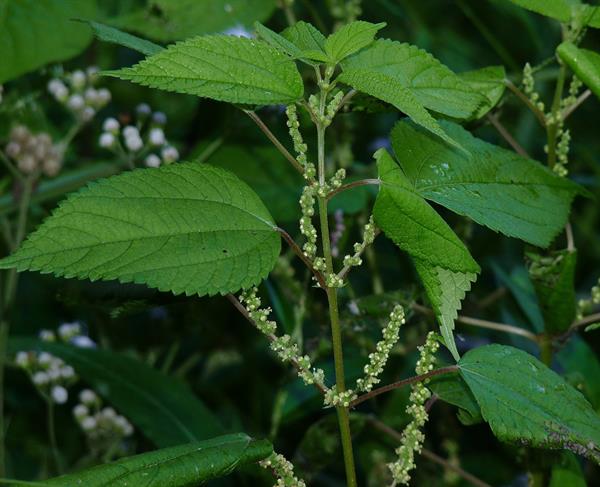
Origin/Endemic status: Native
Synonymy: = Ar, C, FNA3, G, GrPl, GW2, K1, K3, K4, Mex, Mi, NcTx, NE, NY, Pa, RAB, Tn, Va, W, WH3, WI; > Boehmeria austrina Small – S13; > Boehmeria cylindrica (L.) Sw. – S, S13; > Boehmeria cylindrica (L.) Sw. var. cylindrica – F, Il, Tat, Tx; > Boehmeria cylindrica (L.) Sw. var. drummondiana (Wedd.) Wedd. – F, Il, Tx; > Boehmeria cylindrica (L.) Sw. var. scabra Porter – Tat; > Boehmeria decurrens Small – S, S13; > Boehmeria drummondiana Wedd. – S; > Boehmeria scabra (Porter) Small – S13
Wetland Indicator Status:
- Atlantic and Gulf Coastal Plain: FACW
- Eastern Mountains and Piedmont: FACW
- Great Plains: FACW
- Midwest: OBL
- Northcentral & Northeast: OBL
Heliophily: 5
Hover over a shape, letter, icon, or arrow on the map for definition or see the legend.
 © Gary P. Fleming | Original Image ⭷
© Gary P. Fleming | Original Image ⭷ © Bruce A. Sorrie | Original Image ⭷
© Bruce A. Sorrie | Original Image ⭷ © Joey Shaw source | Original Image ⭷
© Joey Shaw source | Original Image ⭷ © Lowell Urbatsch CC-BY | Original Image ⭷
© Lowell Urbatsch CC-BY | Original Image ⭷ © Richard & Teresa Ware CC-BY-NC, permission granted to NCBG | Original Image ⭷
© Richard & Teresa Ware CC-BY-NC, permission granted to NCBG | Original Image ⭷ © Joey Shaw source | Original Image ⭷
© Joey Shaw source | Original Image ⭷ © Erik Danielson source | Original Image ⭷
© Erik Danielson source | Original Image ⭷ © Radford, Ahles and Bell | Original Image ⭷
© Radford, Ahles and Bell | Original Image ⭷Feedback
See something wrong or missing on about Boehmeria cylindrica? Let us know here: (Please include your name and email if at all complicated so we can clarify if needed.)
Cite as...